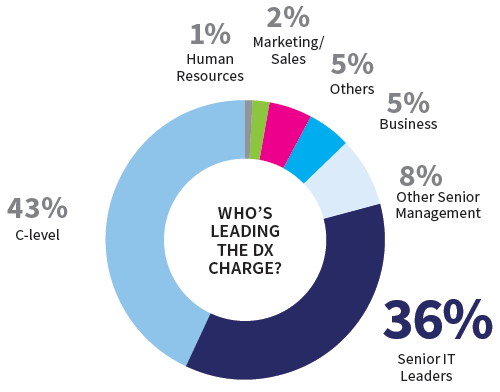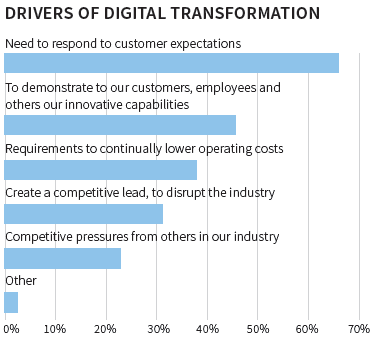Executives who haven’t yet embraced digital transformation have fewer than two years to get onboard, according to the latest CIO Census.
ITBusiness.ca parent company ITWC’s annual report, which this year surveyed 164 CIOs in multiple industries across Canada, found that 57 per cent of respondents believed their business would feel the impact of change now or in the next year, while another 34 per cent expect to see digital transformation to have an impact sometime between the next two and five years.
Only two per cent believed their industry wouldn’t be impacted at all.
“Digital transformation emerged in this census as a real and recognized challenge… intrinsically linked to the need to respond to customer expectations and the need to demonstrate innovative capabilities to customers and employees,” authors Ron Babin, an associate professor of IT Management at Toronto’s Ryerson University, and ITWC CIO Jim Love wrote.
Among those challenges: Identifying who is responsible. Respondents were almost evenly divided between suggesting that digital transformation leadership come from senior IT leaders (40 per cent) or from other executives such as the CEO (39 per cent).
At present, the survey found, C-level executives other than the CIO are more likely to be leading digital transformation efforts at their companies, at a rate of 43 per cent to 36 per cent.

One factor complicating digital transformation adoption and who should lead a company’s efforts to do so is the variety of obstacles in its way, with respondents identifying people issues (organizational resistance, lack of skills, lack of management commitment) as the largest impediment.

The payoffs for pursuing digital transformation are more than worth it: In addition to an improved ability to respond to customer expectations (mentioned by over 65 per cent of respondents), the benefits cited include lower costs (18 per cent), competitive parity (15 per cent), and competitive leadership (20 per cent).
“This suggests that only if organizations can retain/win customers with exceptional experience and lower operating costs will they be able to beat the competition,” Babin and Love wrote.

Beating the digital transformation drum
The study’s consensus on digital transformation matches what many executives have told ITBusiness.ca when interviewed about digital transformation throughout the year. Most recently, City of Toronto executive director of municipal licensing and standards Tracey Cook extolled the virtues of using the blockchain to streamline her department’s job, while citing the success of the city’s award-winning digital registration program for Uber drivers.
“56,000 businesses were coming into the city every year,” she said. “What we’ve done with Uber is license 60,000 on top of that, and that was 100 per cent digital. So that’s still 50,000 people that we could try to enable to deal with us through electronic means.”
Over in the private sector Sun Life Financial, which could boast of such recent innovations as voice-activated digital assistant Ella and Sun Life Go, which allows Canadians to apply for life insurance online, appointed longtime senior vice-president of enterprise services and CTO Stevan Lewis as senior vice-president of digital transformation.
“While the role is new, I would say the journey that we’ve been on over the last few years has been leading up to this in many ways,” Lewis said in an October interview. “[Appointing a vice-president of digital transformation] is really just about putting a bit more focus on and kind of amplifying our digital efforts.”
Even technology companies are placing a greater emphasis on digital transformation, with HP Inc. CEO Dion Weisler telling ITBusiness.ca in September that the accelerated pace of innovation in technologies such as artificial intelligence (AI), data analytics, the Internet of Things (IoT), and 3D printing were having both a positive impact on his business, and creating new demographic and security-related challenges along the way.
“We’re entering an era of ‘omni’ intelligence that’s driven by data and predictive analytics, and the pace of change is exponential,” he said. “AI will improve nearly every aspect of our lives, analytics will help us unlock new business models, IoT means we will have constant real-time communication with all our devices, and 3D printing will make manufacturing easier.”
“But with all of that comes all-out security warfare, and we need to be ready for that.”





